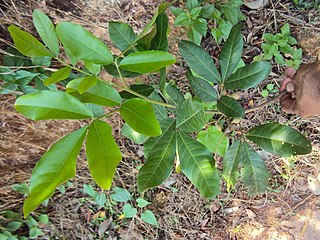
Primula is a genus of herbaceous flowering plants in the family Primulaceae. They include the primrose, a familiar wildflower of banks and verges. Other common species are P. auricula (auricula), P. veris (cowslip), and P. elatior (oxlip). These species and many others are valued for their ornamental flowers. They have been extensively cultivated and hybridised. Primula are native to the temperate Northern Hemisphere, south into tropical mountains in Ethiopia, Indonesia, and New Guinea, and in temperate southern South America. Almost half of the known species are from the Himalayas.

Lactuca, commonly known as lettuce, is a genus of flowering plants in the family Asteraceae. The genus includes at least 50 species, distributed worldwide, but mainly in temperate Eurasia.

Andromeda polifolia, common name bog-rosemary, is a species of flowering plant in the heath family Ericaceae, native to northern parts of the Northern Hemisphere. It is the only member of the genus Andromeda, and is only found in bogs in cold peat-accumulating areas. Andromeda glaucophylla is a synonym of A. polifolia var. latifolia.

Dipteryx is a genus containing a number of species of large trees and possibly shrubs. It belongs to the "papilionoid" subfamily – Faboideae – of the family Fabaceae. This genus is native to South and Central America and the Caribbean. Formerly, the related genus Taralea was included in Dipteryx.

Leucaena is a genus of flowering plants in the mimosoid clade of the subfamily Caesalpinioideae of the family Fabaceae. It contains about 24 species of trees and shrubs, which are commonly known as leadtrees. They are native to the Americas, ranging from Texas in the United States south to Peru. The generic name is derived from the Greek word λευκός (leukos), meaning "white," referring to the flowers.
Zygia cognata is a tree species in the legume family (Fabaceae). It is found in Belize, Guatemala, and Honduras.

Sonchus splendens, synonym Dendroseris macrophylla, is a species of flowering plant in the family Asteraceae. It is endemic to the Juan Fernández Islands of Chile. It is threatened by habitat loss.

Aglaia elaeagnoidea, the droopy leaf or priyangu, is a species of plant in the family Meliaceae. It is a 10m tall tree found in American Samoa, Australia, Cambodia, China, India, Indonesia, Malaysia, New Caledonia, Papua New Guinea, the Philippines, Samoa, Sri Lanka, Taiwan, Thailand, Vanuatu, and Vietnam.
Mitranthes macrophylla is a species of plant in the family Myrtaceae. It is endemic to Jamaica. It is threatened by habitat loss.
Pentagonia spathicalyx is a species of flowering plant in the family Rubiaceae, native to western South America to north Brazil. It was first described by Karl Moritz Schumann in 1889.
Pentagonia rubriflora is a species of plant in the family Rubiaceae. It is endemic to Peru.
Baphiopsis parviflora is an African species of flowering plants in the legume family, Fabaceae. It is the sole species in genus Baphiopsis. It is a shrub or tree which ranges from Cameroon to Tanzania and Angola.

Nuxia floribunda, the forest elder, forest nuxia or wild elder, is a species of tree in the Stilbaceae family, that is native to moist regions of southern Africa, East Africa and central tropical Africa.
Beilschmiedia gaboonensis is an evergreen tree in the subgenus Hufelandia of the genus Beilschmiedia, in the family Lauraceae. It is native to central Africa. It is a medium-sized tree which can measure up to 30 m tall with a bole diameter of up to 60 cm. It is distributed from southern Nigeria to the Congo basin, occurring in Cameroon, Gabon and Zaïre. It is associated with marshy locations in lowland rainforest. Similarly to Beilschmiedia mannii, it is known under the trade names "kanda" and "pink kanda". The bark is used in analgesic and healing ointments.

Pentagonia is a genus of over 40 species of plants in the Coffee or Gardenia family (Rubiaceae}. Pentagonia species are native to Central America and northern South America, and grow in moist tropical forests below 900m. The genus was first described by George Bentham in 1845. The genus is noteworthy for its opposite pairs of huge leaves in a variety of shapes including entire, shallowly or deeply lobed, and even pinnate. These leaves can, in the case of a recently discovered species be up to four feet long not including the six inch petiole, and up to 2.5 feet in width.

Dialypetalantheae, synonym Condamineeae, is a tribe of flowering plants in the family Rubiaceae and contains about 305 species in 31 genera. Most genera are found in Central and Southern Tropical America, but a few occur in Southeast Asia.

Nuxia congesta, commonly known as brittle-wood, is a species of tree in the Stilbaceae family, with an extensive range in the Afrotropics. The species is named congesta for its dense inflorescences.
Phaseolus pauciflorus is a species of wild bean native to Mexico and Guatemala.

Mollia is a genus of flowering plants belonging to the family Malvaceae. It is within the Grewioideae subfamily, and the Grewieae tribe.

Lysiloma divaricatum is a flowering tree native to Mexico and Central America. Common names include mauto, quitaz, and tepemesquite in Mexico, quebracho in Honduras, Mexico, and Nicaragua, and quebracho negro, tepemisque, and yaje in El Salvador.













